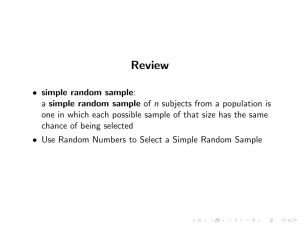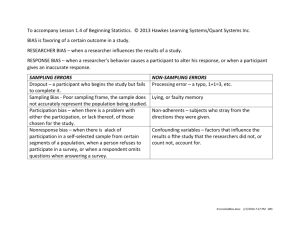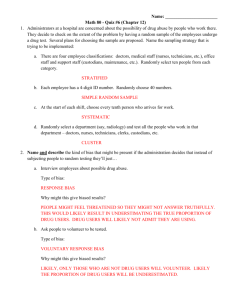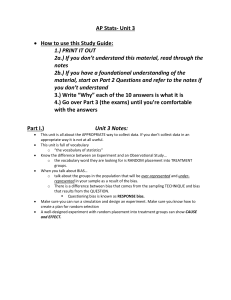Chapter 01.pptx
advertisement
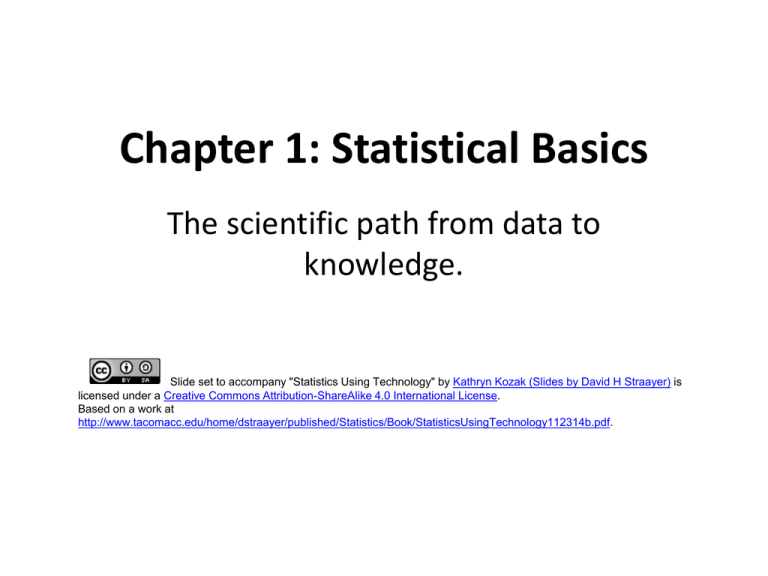
Chapter 1: Statistical Basics The scientific path from data to knowledge. Slide set to accompany "Statistics Using Technology" by Kathryn Kozak (Slides by David H Straayer) is licensed under a Creative Commons Attribution-ShareAlike 4.0 International License. Based on a work at http://www.tacomacc.edu/home/dstraayer/published/Statistics/Book/StatisticsUsingTechnology112314b.pdf. Data to Knowledge • Statistics is the study of how to collect, organize, analyze, and interpret data collected from a group. • Two branches: – descriptive statistics (collect & organize data) – inferential statistics (analyze & interpret data) 1.1: Some key terms • Individual – a person or object that you are interested in finding out information about. • Variable (also known as a random variable) – the measurement or observation of the individual. • Population – set of all the entire group of individuals about which we are interested. • Sample – a subset from the population. It looks just like the population, but contains less data. Parameters and Statistics • Parameter – a number calculated from the population. Usually denoted with a Greek letter. This number is a fixed, unknown number that you want to find. • Statistic – a number calculated from the sample. Usually denoted with letters from the Latin alphabet, though sometimes there is a Latin letter with a ^ (“caret” called a hat) above it. Sometimes we just put a bar over the letter (𝑥)and pronounced something like x-bar. Since you can find samples, it is readily known, though it changes depending on the sample taken. It is used to estimate the parameter value. Types of variables • Qualitative or categorical variable – answer is a word or name that describes a quality of the individual. • Quantitative or numerical variable – answer is a number, something that can be counted or measured from the individual. • If it’s a number, it’s probably quantitative – unless it makes no sense to do artithmetic. Measurement Scales • Nominal – data is just a name or category. There is no order to any data and since there are no numbers, you cannot do any arithmetic on this level of data. Examples of this are gender, car name, ethnicity, and race. • Ordinal – data that is nominal, but you can now put the data in order, since one value is more or less than another value. You cannot do arithmetic on this data, but you can now put data values in order. Examples of this are grades (A, B, C, D, F), place value in a race (1st, 2nd, 3rd), and size of a drink (small, medium, large). • Interval – data that is ordinal, but you can now subtract one value from another and that subtraction makes sense. You can do arithmetic on this data, but only addition and subtraction. Examples of this are temperature and time on a clock. • Ratio – data that is interval, but you can now divide one value by another and that ratio makes sense. You can now do all arithmetic on this data. Examples of this are height, weight, distance, and time. Families of numbers • Counting numbers: – Integers, Whole numbers, Natural Numbers – No “in-betweenies” • Measuring numbers – Fractions, decimals, scientific notation, … – For any two distinct (different) numbers, there’s always one between them. Section 1.2: Sampling Methods • census – not really a sample (Try to measure all) • simple random sample – every different possible sample of size n has the same chance of being selected. • stratified sample – divide into strata, randomly select in each. • systematic sample – every nth, for example. • cluster sample – divide into clusters, randomly select clusters, sample some or all in selected clusters. • convenience sample – not statistically valid. The problem of Bias • Bias means that a sample does not represent the population from which it was drawn. • Hence, conclusions from the sample may not apply to the population as a whole. • Biases can be anticipated or unanticipated. • Randomization is the key to avoid bias. Section 1.3: Experimental Design • Observational Study – when the investigator collects data merely by watching or asking questions. He doesn’t change anything. • Experiment – when the investigator changes a variable or imposes a treatment to determine its effect. Section 1.3: Experimental Design Guidelines for planning 1. 2. 3. 4. 5. 6. 7. 8. Identify individuals of interest. Specify variable (or variables). Specify population. Specify method for measuring or observing. Determine sampling method. Collect data. Use inference to come knowledge. Refine (problems, recommendations) Observation vs Experiment • Observational Study – when investigators collect data merely by watching or asking questions. They don’t change anything. Very hard to establish cause-and-effect. • Experiment – when the investigator changes a variable or imposes a treatment to determine its effect. Intended to establish cause-and-effect. Experimental Options • Randomized two-treatment experiment – Control is key concept. Placebo is often used for control. • Randomized Block Design – a block is a group of subjects that are similar, but the blocks differ from each other. Then randomly assign treatments to subjects inside each block • Rigorously Controlled Design – carefully assign subjects to different treatment groups, so that those given each treatment are similar in ways that are important to the experiment • Matched Pairs Design – the treatments are given to two groups that can be matched up with each other in some ways. Other aspects of experimentation • Replication Nobody is going to make major changes based on a single study. That what graduate students are for. • Blinding – Single blinded: subjects does not know if treatment or placebo – Double blinded: Those experimenters doing the measuring don’t know either. Experiments and time • Cross-sectional study – data observed, measured, or collected at one point in time. • Retrospective (or case-control) study – data collected from the past using records, interviews, and other similar artifacts. • Prospective (or longitudinal or cohort) study – data collected in the future from groups sharing common factors. Section 1.4: How Not to Do Statistics • lurking or confounding variables – when you cannot rule out the possibility that the observed effect is due to some other variable rather than the factor being studied. • Overgeneralization – where you do a study on one group and then try to say that it will happen on all groups. Cause and effect • Where people decide that one variable causes the other just because the variables are related or correlated. • It is very difficult to establish cause from observation alone. Sometimes we have no choice but to try – Cigarettes and lung cancer – Climate change and fossil fuels Other issues • Sampling error – This is the difference between the sample results and the true population results. • Nonsampling error – This is where the sample is collected poorly either through a biased sample or through error in measurements. Care should be taken to avoid this error. Significance – two meanings • Statistical Significance – The results are probably not due to the chance of sampling • Practical or Clinical Significance – Does the effect really matter? Bias in Surveys • The wording of the questions can cause hidden bias – where the questions are asked in a way that makes a person respond a certain way • Non-response – where you send out a survey but not everyone returns the survey • Voluntary response – where people are asked to respond via phone, email or online. The problem with these is that only people who really care about the topic are likely to call or email.



